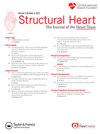小主动脉瓣环上与瓣环内自扩张瓣膜:倾向评分匹配研究
IF 1.4
Q3 CARDIAC & CARDIOVASCULAR SYSTEMS
引用次数: 0
摘要
背景:对于小主动脉环空(SAA)患者,经导管主动脉瓣置换术(TAVR)与自膨胀瓣膜(sev)在环上瓣膜(sav)或环内瓣膜(IAVs)可能有不同的结果,但这一主题仍未得到充分探讨。我们的目的是评估不同sev之间的结果,即sav (CoreValve/Evolut R/PRO/PRO+/FX)与iav (Portico/Navitor)。方法选取2013年至2023年伴有sev行TAVR的SAA(最大直径23mm)患者的单中心数据,然后进行1:1倾向评分匹配(PSM)。结果86对PSM患者,中位年龄为83.0岁(SAVs)和82.0岁(IAVs),其中女性患者占77.6%。在TAVR后,我们没有发现以下结果的统计学差异:瓣膜学术研究联盟-3围手术期死亡率、技术成功、装置成功、临床疗效和瓣旁漏率没有统计学差异,但我们发现IAV组永久性起搏器植入率更高(1.2比8.1%;P = 0.029)。尽管sav组的有效指向性孔口面积较大(中位数1.0 vs 0.8 cm2/m2, p = 0.001),但在残差平均梯度>; 20mmhg (0.0 vs. 2.3%, p = 0.155)和严重假体与患者不匹配(2.3 vs. 5.8%, p = 0.390)方面,我们没有发现组间的统计学差异。sav组和iav组患者的生存(log-rank p = 0.950)和脑卒中(p = 0.6547)差异无统计学意义。对于SAA患者,使用SEV装置进行TAVR是安全的。结论siav和sav在血流动力学、结构和非结构功能障碍方面具有可比性。需要随机数据来验证这些发现并指导明智的设备选择。本文章由计算机程序翻译,如有差异,请以英文原文为准。
Supra-Annular Versus Intra-Annular Self-Expanding Valves in Small Aortic Annulus: A Propensity Score-Matched Study
Background
Transcatheter aortic valve replacement (TAVR) with self-expanding valves (SEVs) may have different outcomes with supra-annular valves (SAVs) or intra-annular valves (IAVs) in patients with small aortic annuli (SAA), but this topic remains underexplored. We aimed to evaluate outcomes between different SEVs, namely SAVs (CoreValve/Evolut R/PRO/PRO+/FX) vs. IAVs (Portico/Navitor).
Methods
Single-center data with patients with SAA (maximum diameter <23 mm) who underwent TAVR from 2013 to 2023 with SEVs, followed by 1:1 propensity score matching (PSM).
Results
We obtained 86 PSM pairs with median age of 83.0 years (SAVs) and 82.0 years (IAVs), with women representing 77.6% of the PSM cohort. After TAVR, we did not find statistically significant differences for the following outcomes: Valve Academic Research Consortium-3 periprocedural mortality, technical success, device success, clinical efficacy, and rates of paravalvular leak were not statistically significantly different, but we found higher rates of permanent pacemaker implantation in the IAV group (1.2 vs. 8.1%; p = 0.029). Despite the larger indexed effective orifice area with SAVs (median 1.0 vs. 0.8 cm2/m2, p = 0.001), we did not find statistically significant differences between the groups in terms of residual mean gradients >20 mmHg (0.0 vs. 2.3%, p = 0.155), and severe prosthesis-patient mismatch (2.3 vs. 5.8%, p = 0.390). No statistically significant difference was observed in survival (log-rank p = 0.950) and stroke (p = 0.6547) between patients who received SAVs and IAVs. For patients with SAA, TAVR with SEV devices is safe.
Conclusions
IAVs and SAVs are associated with comparable device performance in terms of hemodynamic structural and nonstructural dysfunction. Randomized data are needed to validate these findings and guide informed device selection.
求助全文
通过发布文献求助,成功后即可免费获取论文全文。
去求助
来源期刊

Structural Heart
Medicine-Cardiology and Cardiovascular Medicine
CiteScore
1.60
自引率
0.00%
发文量
81
 求助内容:
求助内容: 应助结果提醒方式:
应助结果提醒方式:


